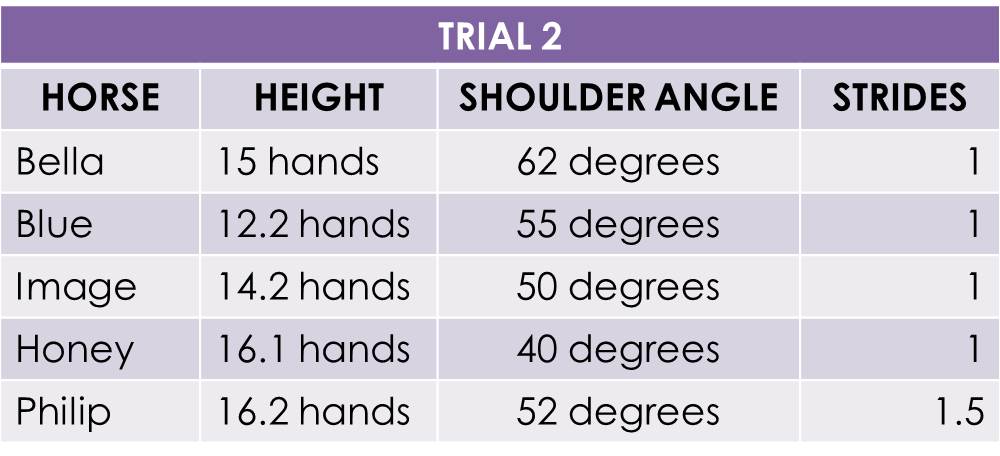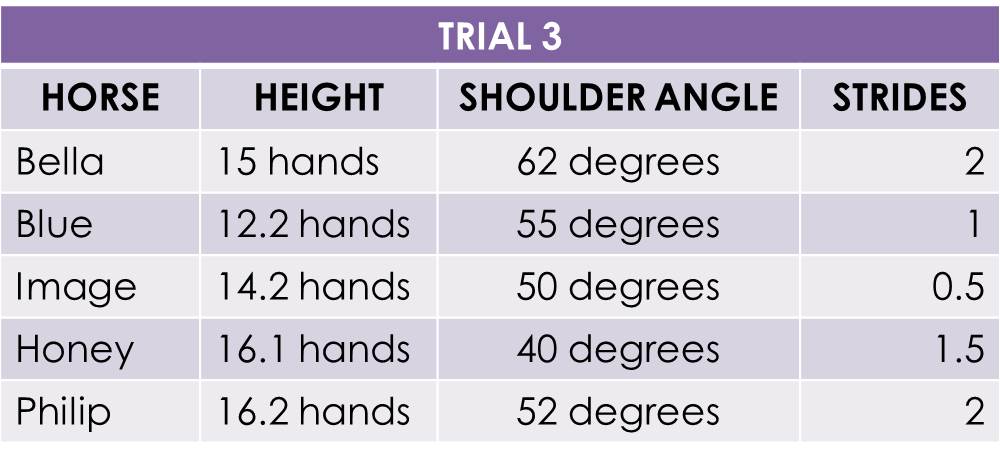Horse Science Experiments
Are you looking for safe, fun horse science experiments for a school project or school science fair? All through middle school, I had to participate in our annual school science fair. Of course, being horsecrazy, I always tried to do science fair experiments involving horses.

At my school, we had to come up with a hypothesis that could be tested and then share the results. I couldn’t do models or book report type projects. But I know every school is different.
Following is the last project I did. Please don’t copy it; I am posting it so you can get an idea of how a science fair project is presented. (I also had to create a poster board with all this information.)
Have you done one of these projects? You will find a lot more ideas for science fair projects with horses here.
Shoulder Angle in Relation to Stride Length
Hypothesis
If the horse or pony has a smaller shoulder angle, then the horse or pony will have a longer stride.
Controls
The controls of this experiment are the distance measured, the poles, the rider, the tack, the protractor, the way the horse’s or pony’s shoulder angle is measured, the place, the camera and printer.
Variables
The dependent variables of this experiment include the horse’s or pony’s stride. The independent variables of this experiment include the time of day, the day, the weather, the horse's attitude, the horses or ponies, horses or ponies shoulder angle, and the horse’s or pony’s height.
Materials
- a protractor
- a digital camera
- a printer
- a marker
- a ruler
- 5 horses and or ponies
- a tape measure
- 2 poles
- saddle
- bridle
- girth
- saddle pad
- a rider
Procedure
- First, have the horse or pony stand square; measure the horse or pony’s height.
- Then, take a picture of the horse or pony; print the picture out.
- From the picture you will then draw a line (with the marker) to the point of shoulder.
- After drawing a line to the point of shoulder draw a line (with the marker) across the horse’s or pony’s body.
- Once these two lines have been drawn measure the horses shoulder angle with the protractor.
- After measuring out 12’ to 6’ distance (depending on if it is a horse or pony) place a pole at the beginning of the distance and at the end, out of the horse’s or pony’s path.
- Have the horse or pony canter the given distance (with the rider on them) while counting the strides they take over the given distance (it should only be one stride).
- Lastly record the results.
Purpose
The purpose of this experiment is to find out if the horse’s shoulder angle or the horse’s height affects its stride.
Problem
Does the shoulder angle or height of the horse affect its stride?
Application
This experiment could be proven useful for people who are buying, selling, riding, jumping a horse or pony. It could even be helpful to people trying to figure out the horse’s or pony’s estimated stride length.
Data



Results
Trial one agreed with the hypothesis. The horses and ponies in trial one reached the correct number of strides for the horse or pony’s shoulder angle.
Trial two mostly agreed with the hypothesis. The horses and ponies in trial two reached the correct number of strides for the horse or pony’s shoulder angle.
Trial three didn't agree with the hypothesis. Three of the horses and ponies were not in the stride length range for the horse or pony’s shoulder angle.
Overall, the hypothesis was supported by the trials.
Conclusion
In conclusion, the hypothesis that was created was agreed with.
Both trial one and two agreed with the hypothesis while trial three disagreed with the hypothesis.
The experiment showed that height has nothing to do with a horse or pony's shoulder angle. Instead, it showed that the larger the horse or pony's shoulder angle, the shorter the stride length.
The three trials did prove the hypothesis.
Recommendations
Variables that might have affected the experiment were the weight of the rider, the tack used, the day, the time, the tiredness of the horse or pony, the weather, the ability of the rider, the health of the horse or pony, the number of trips, the position of the rider, and the height of the rider. These variables could have impacted the outcome of the experiment.
For future improvement, I could use more horses and ponies, use a rider of a different weight,height, or experience. I could also pick a cooler day or maybe also just do one trial a day.
Abstract
The purpose of this experiment is to find out if the horse’s shoulder angle or the horse’s height affects its stride. The subjects of the experiment are three horses and two ponies. If the subject has a smaller shoulder angle, then the subject will have a longer stride.
Trial one agreed with the hypothesis. The subjects in trial one reached the correct number of strides for the subject’s shoulder angle. Trial two mostly agreed with the hypothesis.
The subjects in trial two reached the correct number of strides for the subject’s shoulder angle.
Trial three didn't agree with the hypothesis. For the third trial, three of the subjects were not in the stride length range for the subject’s shoulder angle.
Overall, the hypothesis was supported. In conclusion, the hypothesis was agreed with.
The first two trials agreed with the hypothesis. Trial three disagreed with the hypothesis.
The experiment showed that height has nothing to do with a subject's shoulder angle. Instead, it showed that the larger the subject's shoulder angle, the shorter the stride length.
The controls of this experiment are the distance measured, the poles, the rider, the tack, the protractor, the way the subjects shoulder angle is measured, the location, and the camera and printer.
The dependent variables of this experiment include the subject’s stride. The independent variables of this experiment include the time of day, the day, the weather, the subject’s attitude, the subject’s shoulder angle, and the subject’s height.




